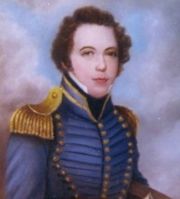James Gadsden
James Gadsden (1788-1858) was an officer in the United States Army who served as aide-de-camp to Andrew Jackson during the War of 1812 and Seminole Wars. In 1818, a detachment led by Gadsden captured an enemy schooner with information leading to the condemnation and execution of Alexander Arbuthnot and Robert C. Ambrister. During the subsequent capture of Pensacola, Gadsden devised the approaches and established the batteries which forced Spanish Governor Jose Masot to surrender. Also in 1818, Gadsden was charged with rebuilding Fort Negro, which Jackson then named "Fort Gadsden" in his honor.
| James Gadsden | |
|---|---|
| Born | May 15, 1788 Charleston, South Carolina |
| Died | December 25, 1858 Charleston, South Carolina |
| Occupation | U.S. Army officer, ambassador to Mexico |
Gadsden again accompanied Jackson to Pensacola in 1821 to assist in the transfer of Florida to the United States, and he is credited with reconciling a dispute between Jackson and Governor Jose Callava.
In Pensacola, Gadsden Street is named for him. He is also the namesake of Gadsden County, Florida, due to his 1823 role in relocating Seminole Indians thence to Oklahoma, and the Gadsden Purchase, which he negotiated as U.S. ambassador to Mexico in 1853.
